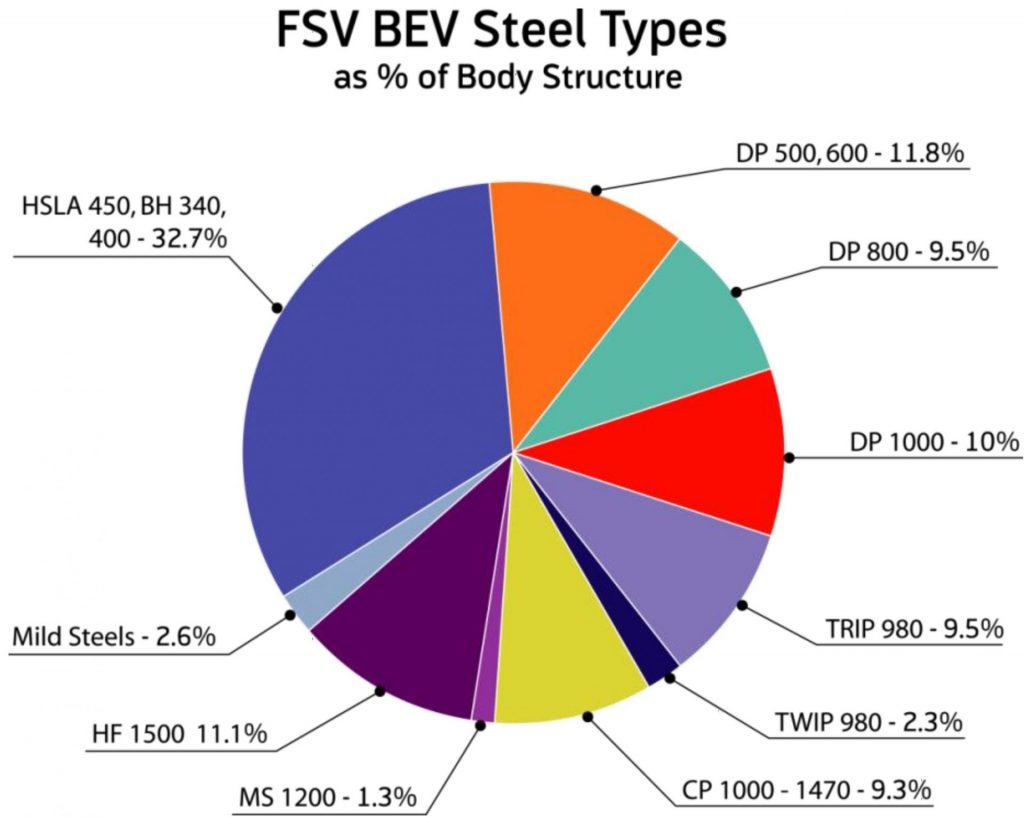Started in 2008, the FutureSteelVehicle (FSV) program built on more than a decade of work finding ways to decrease vehicle mass, reduce cost and meet comprehensive crash safety standards, all in pursuit of a smaller environmental footprint. FSV validated wide ranging research into the practical use of AHSS, innovative design and manufacturing technologies, and proposed specific examples for electrified vehicles (Figure 1). FSV used Life Cycle Analysis (LCA) to select the steels and manufacturing techniques that result in the lowest total carbon footprint, going beyond accounting only for emissions in the use phase.
FutureSteelVehicle drew from a broad portfolio of steel types and grades, in a range of properties from mild to GigaPascal strength levels, applying a vast array of manufacturing processes. With advanced optimization algorithms, FSV incorporated hundreds of variables in the design process to identify a wide band of solutions. This approach integrated vehicle design, powertrain design and packaging, occupant space, passenger ingress/egress, driver sight angles, NVH, and aerodynamics to achieve a body structure that works in harmony with all vehicle requirements related to more stringent emissions and fuel efficiency standards while meeting safety (crash) standards and affordability.
The FSV project included structural variants for battery electric (BEV), plug-in hybrids (PHEV-20 and PHEV-40) and fuel cell (FCEV) powertrains, these same design attributes can be applied to conventional ICE-powered vehicles as well. Figure 2 highlights the FSV body materials breakdown.
Lower Weight
Extensive use of a broad portfolio of AHSS grades, coupled with engineering design optimization, enabled a robust body structure that is feasible to produce and achieves 5-star crash performance against all global crash standards, while also exceeding mass reduction targets. A lower weight, mass-efficient body creates opportunities for downsizing sub-systems, including the powertrain, and promotes reductions in overall vehicle mass. As an example, the body structure mass achievement for the FSV BEV variant is 177 kg W-39, including the battery tray – a component unique to a Battery Electric Vehicle. This compares quite favorably with the 2010 VW Polo, at 231 kg, which was recognized as Car of the Year in Europe because of its mass-efficient design but carries a lighter ICE gasoline powertrain. Table 1 highlights some of the benchmarking comparisons.
| Table 1: FSV Benchmarking | |||||
| Vehicle | Class | Powertrain | Curb Weight | Body Mass | Fuel Consumption (NEDC) |
| FSV – BEV | B+ | BEV | 958 kg | 177 kg | 2.42 l/100 km (equiv) |
| ULSAB – AVC | C | ICE-G | 933 kg | 202 kg | 4.40 l/100 km |
| VW Polo | B | ICE-G | 1067 kg | 231 kg | 5.70 l/100 km |
Lower Cost
Steel is the most cost-competitive material for car bodies. It is economical to fabricate into components and sub-systems and to assemble into the total body-structure assembly. The resulting cost estimate of $1,115 to manufacture and assemble the complete FSV body validated this proposition and represents no cost penalty compared to vehicles at that time.
Lowest Total Lifetime Emissions
FutureSteelVehicle demonstrated the importance of Life Cycle Assessment as an integral element of a vehicle design process. In combination with optimizing the design for mass, cost, and functionality, FSV integrated into all analyses an accounting for its complete environmental footprint as measured in CO2e. It more appropriately comprehends the entire lifetime carbon footprint of the vehicle, not simply the use phase. This includes the entire fuel production cycle (well to pump), the fuel usage cycle (pump to wheels), the production of raw materials, as well as disposal/recycling.
FSV demonstrated that the coupling of a lightweight, AHSS body structure with a battery-electric powertrain results in a 50 to 70 percent reduction in total life cycle emissions, compared to equivalently sized vehicles with conventional gasoline ICEs W-12. Furthermore, based on the new steels’ light weighting capabilities, steel is the only material to realize emission reductions in all life cycle phases. Table 2 summarizes total vehicle carbon footprint and emissions performance by life cycle phase.
|
Table 2: FSV comparison between U.S. and Europe energy grids |
|||
|
Vehicle/Powertrain |
Material & Recycling |
Use Phase |
Total Life Cycle |
| Polo V ICEg |
1,479 |
32,655 |
34,134 |
| FSV BEV USA grid |
1,328 |
13,844 |
15,172 |
| FSV BEV Europe grid |
1,328 |
9,670 |
10,998 |
| FSV vs. Polo V – USA grid |
– 56% CO2e reduction |
||
| FSV vs. Polo V – Europe grid |
– 68% CO2e reduction |
||
Safety
The FSV design anticipated increasingly stringent crash safety standards over the decade following its release and was designed to meet European and U.S. 5-Star crash safety performance requirements over that time W-12. Using the latest holistic design and material optimization approaches combined with steel’s unmatched capabilities for design and manufacturing efficiency, the final FSV design comprised optimized, mass-efficient shapes that met or exceeded these global crash safety requirements.

